What are NFTs? A beginner’s guide by Meta
Creators today use non-fungible tokens (NFT) to take more control over their work, relationships with their communities, and how they can make money. And in the future, we believe NFTs will be crucial to how people will buy, use and share virtual objects and experiences. We recently announced a way for people to showcase NFTs digital collectiblesjust one of the new technologies we are exploring as we build for the metaverse.
“NFT” can sometimes sound like a buzzword, and you may be confused about how it works. So here’s the basics:
What are NFTs?
NFT stands for non-fungible token. “Non-fungible” means that something is unique and cannot be replaced. Think of the Mona Lisa painting – there is only one in the world. NFTs are digital assets that represent things like art, virtual avatars, GIFs, videos, trading cards and even memes.

So if NFTs are digital, what is stopping me from taking screenshots or downloading them?
Sure, you can take a screenshot of an NFT image, just like you can take a picture of the original Mona Lisa. However, you are still not the original owner of NFT or Mona Lisa.
Each NFT has a unique signature that confirms the authenticity and any transactions associated with it – who created it, who owns it, who sold it and for how much, etc. Creating an NFT is called coinage. When a digital file is embossed, an NFT is generated and stored on one blockchain.
Blockchain technology provides an overview of ownership of a public, distributed database that anyone can see. This ownership overview also allows the original creator to always be credited and paid royalties, no matter how many times an NFT is sold or who owns it. The story of ownership, from creator to current owner, is called provenanceand it is a concept that is already in use in the art world.

How do I buy an NFT?
Most often, NFT transactions are done using cryptocurrency, but some websites allow you to use credit or debit cards. To purchase NFTs with cryptocurrency, you need to set up a digital wallet. There are a number of digital wallets available depending on where you live and which blockchains you want to use. For example, we are testing the ability of selected creators and collectors on Instagram to showcase NFTs from compatible third-party wallets such as Rainbow, MetaMask and Trust Wallet, with Coinbase Wallet, Dapper and Phantom coming soon. Then you need to connect your digital wallet to a third-party NFT marketplace, where you can browse and shop NFTs.
How do I create an NFT?
- Choose a unique digital resource (art, music, meme, etc.) you want to sell.
- Decide which blockchain technology you want to use.
- Set up your digital wallet.
- Choose an NFT marketplace.
- Upload the file to the marketplace to create your NFT.
- Once you have your NFT, you can choose to keep it, sell it at a fixed price or by starting an auction, or give it away to your most loyal fans – just like a physical asset, there are many opportunities to deposit NFT. to use.
Why are some NFTs more valuable than others?
Just like works of art in the physical world, NFTs can be rare and valuable. Usually, when an NFT is sold on a marketplace, it is a bidding process where the price of the NFT is determined by how much demand there is for it.
Why are so many people talking about NFTs?
NFTs are an important aspect of the economic and societal potential of the metaverse. We believe NFTs have the opportunity to be an important part of how we form our online identities, gain access to new experiences and engage with others in the meta-verse. Over the next decade, we hope that the meta-verse will reach one billion people, host hundreds of billions of dollars in digital commerce and support jobs for millions. It will of course benefit us as Meta, but most importantly, many other creators, developers and entrepreneurs as well.
What about the risks and challenges associated with NFT?
As with all new technology, navigating risks and challenges. We work to build our products in a responsible, sustainable and inclusive way from the ground up. It is crucial that our early efforts in this space strengthen different voices, are safe and help protect people from fraud, and assess environmental impact. Learn more about how we deal with these challenges.
What’s next for Meta and NFT?
It’s us expands our test of digital collectibles on Instagram to several global creators and a handful more countries. Creators and collectors will be able to share their digital collectibles on Facebook and Instagram after we start rolling out the feature on Facebook with selected US creators at a later date.
Note: This post contains general information about non-fungible tokens (NFT) for general educational purposes only. Information about NFTs can possibly vary. You should always do your own research and be aware of any risks.

